
 Jobs report - no recession but still a rate cut
By R. Mark Rogers, Senior Economist, Econoday
Jobs report - no recession but still a rate cut
By R. Mark Rogers, Senior Economist, Econoday
December 7, 2007

The big story this past week was that employment remains moderately healthy based on the November employment report. But the report was not so strong as to preclude an interest rate cut for the Fed to consider on December 11. However, there are still plenty of reasons for the Fed to worry about inflation. In the meantime, equities continued to rebound as investors increasingly came to the conclusion that the Fed would be cutting the Fed funds target rate by 50 basis points instead of a mere 25 basis points – least they did until employment report Friday.
Equities continued to rebound from levels depressed two weeks ago by credit market concerns as the markets during most of the week increasingly expected a 50 basis point cut in interest rates by the Fed on December 11 and as the November jobs report helped recession fears fade.
The week got off to a bad start with declines on Monday and Tuesday. Credit concerns were one of the big issues on Monday as the markets soaked in comments by Treasury Secretary Henry Paulson that the government rescue plan for troubled mortgage borrowers implied that the subprime lending problem was going to take a lot longer than many had believed. Also, disappointing results from automakers Ford and GM weighed on the markets. Tuesday’s decline was led by financials and comments by San Francisco Fed President Janet Yellen on Monday evening implying that the Fed was beginning to see the economy in more serious trouble than believed a few weeks earlier – implying a greater chance of recession. Strong productivity numbers and a jump in ADP employment estimates for November boosted equities at mid-week, along with an increased belief that the Fed would be easing by 50 basis points on December 11. Stocks continued upward on Thursday with the bullish mood fueled primarily by optimism about a large Fed ease coming. Also, Wal-Mart reported positive sales for November. The Treasury announced a limited bailout plan for subprime borrowers and this lifted many financial stocks, notably Countrywide. Techs got sizeable boosts on Wednesday and Thursday from analysts upgrades based on demand for electronics. Equities were little changed on the last trading day as the employment report was seen as largely meeting expectations but also seen cutting into the odds of a 50 basis point rate cut by the Fed. Expectations of a rate cut by the Fed are the primary factor supporting the equity markets, followed by economic data that for now have ruled out recession.
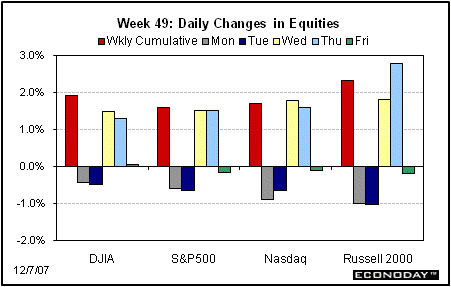
Last week, most major indexes were up: the Dow, up 1.9 percent; the S&P 500, up 1.6 percent; the Nasdaq, up 1.7 percent; and the Russell 2000, up 2.3 percent.
Year-to-date, the Dow is up 9.3 percent; the S&P 500, up 6.1 percent; and the Nasdaq, up 12.0 percent. The Russell 2000 is down 0.3 percent since year end.
Rates on bonds rebounded this past week. But rates initially headed in the other direction as Treasury rates fell on Monday as Moody’s Investor Service downgraded a hefty amount of structured investment vehicles, leading to flight to quality. Rates were little changed on Tuesday for the most part. Rates headed back up steadily over the last three days of the week. ADP’s unexpectedly high estimate for private payrolls to swell by 189,000 in November nudged rates up as did flow of funds into equities. Rates continued upward on Thursday, primarily reflecting a reversal of flight to quality as equities posted solid gains. Friday’s moderately healthy jobs report boosted rates the last day of the week, with the bond market being more sensitive to the spike in wage rates.
Treasury yields were up last week as follows: the 2-year note; up 9 basis points; the 5-year note, up 11 basis points; the 10-year bond, up 17 basis points; and the 30-year bond, up 19 basis points. The 3-month T-bill slipped 7 basis points over the week.

Rates were up last week except on the near end on some reversal of flight to quality and a drop in recession concern due primarily to the November job gain. The 3-month T-bill remained near lows not seen since early 2006.
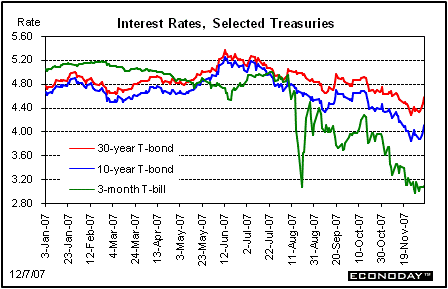
Oil prices saw a number of swings last week but ended down slightly. A number of factors affected the daily swings. Prices fell notably on Tuesday due in large part to a U.S. intelligence report that Iran halted its nuclear weapons program in 2003 and also due to comments by OPEC delegates that the organization might be increasing production. Inventory data pushed prices down on Wednesday even though crude stocks were down much more than expected. Both gasoline and distillate stocks rose unexpectedly and sharply, indicating a weakening in demand in the U.S. In contrast, the impact of growth overseas was the factor behind a $2.74 per barrel spike in prices on Thursday. The OECD issued a forecast for stronger economic growth in China. China is the world’s second largest energy consumer behind the U.S. Prices fell a sharp $2.51 per barrel on Friday as the November jobs report disappointed the oil markets and suggested softer energy demand in the U.S. Apparently, oil traders were much more bullish on jobs expectations than those in equity or bond markets.
The spot price for West Texas Intermediate slipped $0.43 per barrel for the week to close at $88.28 per barrel, $10.60 below the record high of $98.88 per barrel set November 20th.


Weekly percent change column reflects percent changes for all components except interest rates. Interest rate changes are reflected in simple differences.
The November jobs report was the highlight for this past week. While the overall economy is soft, the employment report came very close to being “just right.”
The markets have been looking over both shoulders lately, worrying about the possibility of recession and also whether economic data might come in too strong for the Fed to cut interest rates. The November jobs report seems to have come very close to alleviating both of those fears. However, it nonetheless gave the Fed much to still worry about on the inflation front.
Nonfarm payroll employment in November posted a healthy 94,000 gain, following revised increases of 170,000 in October and 44,000 in September. The initial October estimate of a 166,000 increase was revised up 4,000 and September was revised down 52,000 from the prior estimate of a 96,000 increase. For October and September combined, the net revision was down 48,000. As in recent months, the November gains in employment were in the service sector as both construction and manufacturing jobs declined. Within the service-providing industries, gains were led by professional & business services, government, leisure & hospitality, and retail trade.
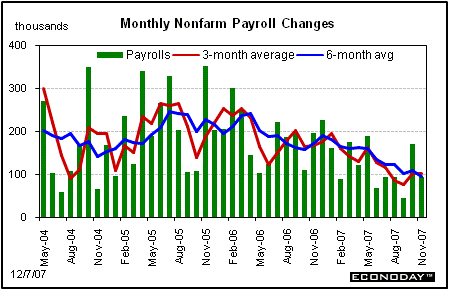
A key point from November’s report is that while payroll gains have had some soft months recently, the magnitude of the increases on average has been in a healthy range. By either a 3-month average or a 6-month average, payroll gains have been in the 100,000 per month vicinity and well above any recession pace – which actually would be negative.
But there is no denying that job growth has been slowing – something the Fed wants to help ease inflation. On a year-on-year basis, nonfarm payroll employment declined to up 1.1 percent in November from up 1.2 percent in October. The year-on-year payroll growth rate had been as high as 2.2 percent as recently as December 2006.

But the employment report was not “perfectly” just right. There are indications that wage pressures are likely still a concern for the Fed. On the inflation front, average hourly earnings posted a 0.5 percent surge in November, following a 0.1 percent increase in October. While the latest jump in wages is quite high, the good news is that it followed a soft September. But the year-on-year rate rebounded to 3.8 percent in November from 3.6 percent in October.
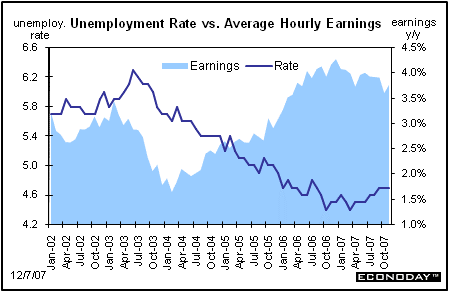
The household survey also shows a somewhat tight labor market. The civilian unemployment rate held steady at 4.7 percent in November. This is only slightly higher than the cyclical low of 4.4 percent seen most recently just this past March. The unemployment rate is not likely to rise to the Fed’s forecast for a fourth quarter average of 4.8 to 4.9 percent for the central tendency forecast. To get a fourth quarter average of even 4.8 percent, the December monthly rate would have to jump to 4.9 percent. This could happen but to get to a 4.9 percent average for the quarter, the December monthly rate would have to come in at 5.2 percent which is very unlikely. The point is that the labor market is not as soft as the Fed appears to have been anticipating. Interest rates will likely be cut on December 11, but there are reasons the Fed will not be very excited about doing so. Traders in the fed funds futures market pulled back on their bet for a 50 basis point cut with odds at close on Friday resulting in a 59 percent probability for a 25 basis point cut and a 41 percent probability for a 50 basis point cut.
There are two notable incidentals related to the report. First, manufacturing may not be as soft as suggested by employment alone. The average manufacturing workweek edged up from 41.2 hours in October to 41.3 hours in November. Aggregate hours in manufacturing rebounded 0.2 percent in November, following a 0.4 percent decrease in October. The November increase suggests that industrial production is likely to be modestly positive for the month.
Secondly, the November gain in payroll jobs came in well below the ADP “forecast.” The ADP report for November was released on Wednesday before Friday's official jobs report and it estimated that private sector jobs would jump by 189,000. In contrast, the actual number for job gains in the private sector was a modest 64,000. The ADP jobs report appears to have a number of big misses.
A big area of concern for the current economy is the health of the consumer sector. Retailers have been reporting soft retail sales. But at least one key portion of the consumer sector is not worsening. Motor vehicle sales in November showed a slight month-to-month increase with a U.S.-made annual rate of 12.2 million, up one tenth from a 12.1 million rate in October. Cars were a standout in the month, selling at a U.S.-made rate of 5.5 million, well above trend and reflecting a consumer shift toward cars and away from low mileage trucks. Higher gasoline prices are crimping truck sales which came in at a 6.7 million rate, one of the lowest rates of the expansion.

Productivity and labor costs in the third quarter were highly favorable for low inflation and even more so with revisions. Third quarter productivity was revised up sharply to an annualized 6.3 percent increase, following a 2.2 percent gain in the second quarter. The third quarter boost was highest quarterly increase since the 10.4 percent surge in the third quarter of 2003. Unit labor costs dropped 2.0 percent annualized in the third quarter, following a 1.1 percent decline in the second quarter. The third quarter decrease was the largest since the 4.5 percent drop in the third quarter of 2003.
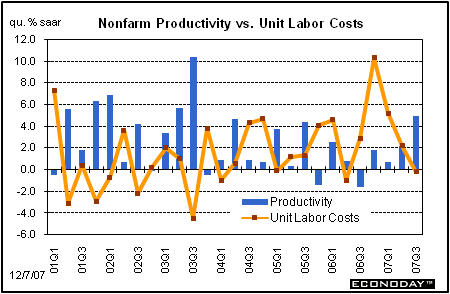
While the markets got excited about the third quarter productivity and labor cost improvement, a key point looking forward is that the improvement will be partially reversed by weak economic growth in coming quarters. The third quarter numbers essentially are anomalies of the spike in GDP. Nonetheless, the third quarter data may well provide a smoke screen for the Fed to cut interest rates on December 11.
Year-on-year, productivity was up 2.7 percent in the third quarter, compared to up 0.7 percent the prior quarter. Year-on-year, unit labor costs in the third quarter stood at up 3.0 percent, down from up 4.2 percent in the prior quarter.

Factory orders in October rose 0.5 percent, following a 0.3 percent gain the prior month. Strength was in nondurables and likely was price related and does not reflect true strength for manufacturing. Nondurables posted a 1.3 percent advance in October, following a 2.1 percent rise the month before. Gains were led by petroleum & coal products, chemical products, and plastics & rubber products -- all heavily affected by the price of oil which has been rising sharply. Orders for durable goods slipped 0.2 percent, following a 1.4 percent decline in September.

More data are pointing to a weak fourth quarter with manufacturing slowing significantly. The ISM manufacturing index for November slipped 1 tenth to 50.8, which is barely above the break-even point of 50 which indicates no growth. New orders are probably the most important component in the report and this index tells the same story, up 1 tenth at 52.6. Production bounced back on the month, up more than 2 points and back above the 50 level at 51.9. The weak dollar is still helping exports as the new export index rose 1.5 points to 58.5. The survey points to more inflation pressure as the prices paid index rose 4.5 points to 67.5.

Housing is in recession. Manufacturing is flattening. And now non-manufacturing sectors in the economy are showing signs of slowing. The ISM's non-manufacturing index for November slipped 1.7 points to 54.1. This level is still in positive territory but indicates only very moderate growth. The overall index is at a seven month low. Importantly, new orders have come down from moderate positive levels to being flat – suggesting further slowing in coming months.

On the inflation front, the ISM non-manufacturing index is also pointing to rising inflation pressures. The prices paid index jumped 13 points to 76.5, reflecting the effect of high gas prices.
The November jobs report has helped fears of recession fade and the increased belief by many (even though not as many as just before the November jobs report) that the Fed will cut interest rates by 50 basis points has provided a significant portion of the lift in equities. While the economy seems to be dodging the bullet in terms of avoiding recession, the Fed’s decision on December 11 could either provide an end-of-year boost in equities, or could pull the rug out on much of the year’s gains.
This coming week’s highlight is the FOMC announcement due out on Tuesday afternoon. But there also are some heavy duty indicators later in the week -- including retail sales, the consumer price index, and industrial production.
The FOMC announcement for the December 11 FOMC policy meeting is expected to cut the fed funds target rate by 25 to 50 basis points. A sizeable share in the fed funds futures market expects a 50 basis point cut – though now less than 50 percent. Still, look for big market reactions if the Fed only cuts by 25 basis points or if there is language in the meeting announcement implying that the Fed is “done” with further rate cuts for now.
FOMC Consensus Forecast for 12/11/07 policy vote on fed funds target: 25 basis point cut to 4.25 percent
Range: 100 percent probability for 25 basis point cut based on fed funds futures settle on December 7, 2007 and a 41 percent probability for a 50 basis point cut
The U.S. international trade gap unexpectedly narrowed slightly in September to $56.5 billion from a revised $56.8 billion in August. The improvement reflected exports rising notably faster than import gains. The weak dollar helped exports, notably with strength in September in food, feeds & beverages; industrial supplies, and consumer goods. A slip in capital goods exports was primarily related to volatility in aircraft exports. Import strength in September was in capital goods, automotive, and consumer goods. Industrial supplies declined despite a jump in the crude oil subcomponent. Based on continued weakness in the dollar and healthy economic growth overseas, exports are likely to continue upward. Oil imports are likely to jump due to higher prices but non-oil imports either will slow due to softening U.S. demand or inventories will be building and eventually will force slower import growth. One definitely will have to look at export and import components and price effects to fully sort out export and import trends – the overall trade gap will not be saying much alone except for near-term impact on the dollar.
International trade balance Consensus Forecast for October 07: -$57.0 billion
Range: -$58.6 billion to -$55.5 billion
Import prices are starting to feed overall inflation pressures as import prices jumped 1.8 percent in October for a steep year-on-year rate of 9.6 percent. Most of the impact was related to oil prices. Still, prices excluding petroleum rose 0.5 percent in October with the year-on-year rate at 3.2 percent, the latter an elevated rate that is certain to raise concern at the Federal Reserve. The weaker dollar and higher oil prices are likely to create significant upward pressure on import prices in the near term.
Import prices Consensus Forecast for November 07: +2.0 percent
Range: +0.7 to +2.7 percent
The U.S. Treasury monthly budget report showed a deficit for October of $55.6 billion versus a deficit in October 2006 of $49.3 billion. October is the first month of the Treasury's fiscal year, which so far is off to a bad start at an increase of 12.8 percent. The month of November typically shows a moderate deficit for the month. Over the past 10 years, the average deficit for the month of November has been $45.6 billion.
Treasury Statement Consensus Forecast for November 07: -$90.0 billion
Range: -$101.0 billion to -$72.3 billion.
Initial jobless claims fell 15,000 in the week ending December 1 to a less worrisome level of 338,000 that is well below the 350,000 level that claims appeared to be testing in recent weeks. With the big miss by the November ADP report in forecasting November’s payroll gain which turned out moderate not robust, the markets will continue to focus on initial claims as one of the more reliable labor market indicators.
Jobless Claims Consensus Forecast for 12/8/07: 337,000
Range: 330,000 to 350,000
Retail sales came in on the soft side for October, up 0.2 percent overall and following a 0.7 percent gain the month before. Excluding motor vehicles, October sales advanced a modest 0.2 percent, following a 0.3 percent rise in September. Gasoline unfortunately once again posted a steep increase, up 0.8 percent following a 1.8 percent jump in September. Excluding both vehicles and gasoline, retail sales inched only 0.1 percent higher in October, following a 0.2 percent gain in September. More recently, retailers generally have announced soft sales for November and weekly store sale reports are also corroborating a below par month. But still, one should look for a jump in overall sales and for ex-autos with a spike in gasoline sales the reason.
Retail sales Consensus Forecast for November 07: +0.6 percent
Range: +0.1 to +0.9 percent
Retail sales excluding motor vehicles Consensus Forecast for November 07: +0.7 percent
Range: +0.4 to +1.0 percent
The producer price index increased a modest 0.1 percent in October, following a 1.1 percent boost in September. The core rate held steady with no change, following a 0.1 percent rise in September. However, some special factors kept both rates soft for the latest month. For the overall PPI, the latest gain was kept soft by declines in energy and light trucks. Weakness in the overall PPI was due to a drop in truck prices and due to a temporary dip in energy costs. Energy is likely to be headed upward while truck prices may remain soft but not as much as in October in general.
PPI Consensus Forecast for November 07: +1.6 percent
Range: +0.5 to +2.3 percent
PPI ex food & energy Consensus Forecast for November 07: +0.2 percent
Range: 0.0 to +0.2 percent
Business inventories rose 0.4 percent in September, in a gain that's on the high side though still under a 0.6 percent rise for business sales that held the stock-to-sales ratio at 1.27. Excluding auto dealers, business inventories were a little more swollen with a gain of 0.5 percent. Inventories at furniture stores and department stores showed especially steep gains, reflecting in part the recession in housing. Overall, inventories are putting pressure on manufacturers to slow production and for businesses to cut back on imports. Inventories are likely to rise notably as U.S. demand has softened. As usual, the devil is in the details and one will have to look at subcomponents to see if inventory impact will be more on domestic production or on imports.
Business inventories Consensus Forecast for October 07: +0.3 percent
Range: +0.1 to +0.3 percent
The consumer price index was a little on the high side overall due to energy costs in October with a 0.3 percent in October, which equaled the gain in September. For October, the core CPI inflation rate increased 0.2 percent, after rising 0.2 percent in each of the prior four months. Energy costs played a key role in the overall CPI increase. The core CPI was mixed in terms of component strength and weakness. Year-on-year, the overall CPI jumped to up 3.5 percent in October from 2.8 percent in September. The core rate was unchanged at 2.1 percent in October on a year-on-year basis. While the Fed will have made its latest policy decision three days prior to this CPI release, this report will start the debate over whether the Fed will cut interest rates at the FOMC meeting in seven weeks at the end of January.
CPI Consensus Forecast for November 07: +0.7 percent
Range: +0.2 to +0.8 percent
CPI ex food & energy Consensus Forecast for November 07: +0.2 percent
Range: +0.1 to +0.4 percent
Industrial production fell 0.5 percent in October, following a 0.2 percent up tick the month before. The manufacturing component dropped 0.4 percent in October, following a 0.2 percent gain the prior month. For October, utilities output fell 1.6 percent while mining output declined 0.6 percent. Overall capacity utilization fell in line with the output drop, declining to 81.7 percent in October from 82.2 percent the month before. More recently, manufacturing indicators have been mixed with regional manufacturing surveys mostly marginally positive but factory orders have been soft outside of industries affected by price hikes in petroleum. Aggregate hours in manufacturing rebounded 0.2 percent in November, following a 0.4 percent decrease in October. The November increase suggests that industrial production is likely to be modestly positive for the month.
Industrial production Consensus Forecast for November 07: +0.1 percent
Range: -0.2 to +0.3 percent
Capacity utilization Consensus Forecast for November 07: 81.7 percent
Range: 81.4 to 81.8 percent



|

![[Econoday]](images/econoday_logo_slim.gif)
![[Econoday]](images/logo.gif)













